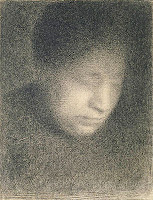I started off by studying some human anatomy from books and the Internet. Due to my background and studies I am very familiar with anatomy so felt quite confident with it. I did some sketches of the skeleton and muscles to remind myself.
I then set to the project, starting with a standing pose. I did a few sketches from different angles.
I wanted to include the back because the s-shape of the spine casts nice shadows, but I also wanted to see the face so I thought the best pose would be of the model twisting half round. This way there was some movement in the pose too, with the upper body rotating and the lower body rooted to the spot. I tried a couple of media. The first sketch was using pen, the second conte pastel pencils and the third and fourth were charcoal. I was surprised how difficult I found the pastel and charcoal at this size (A4). I decided to use pen and ink for this drawing. I had in my head a very simple ink drawing just showing the shadows and highlights but it didn't really work out like that.
| A3 nib pen and ink on 135g paper |
Instead I found that the ink was very good at showing the shape of the figure. I could define the roundness of the muscles and show the imagined direction of the fibres. Unfortunately if I made a mistake with the direction though it really made a difference to the overall drawing. I'm pleased with the drawing but would like to give it another go with that knowledge. I also made a bit of a mess of the face, as usual! I really find it difficult to get faces right on this scale. I'm not so bad if they are portraits but when they are small, tiny changes make so much difference. Also I find it difficult to draw his beard without it looking like a shadow.
Next, the sitting pose. I tried a few angles before I decided on my favourite. I wanted to use charcoal with this one. I think charcoal lends itself to drawing figures because you can soften the changes in tones by blending the charcoal.
I used the sketches to help me choose a pose I liked with the light coming from the best direction to give optimal shadows. The first angle was more from the front and I really liked the foreshortening effect on the right thigh. The composition was nice as well, giving a pleasing triangular shape. However I thought it would be nice to include the back in the drawing. In hindsight I think this angle might have been a good choice although the one I opted for was also interesting. I tried some sketches from both sides but the view from the left gave a more open pose and showed the chest better.
| A3 charcoal on 135g paper |
Because there was a mirror behind the model I had a lot of reflected light to put in, I'm not sure if this confused the final piece. I was excited about the way the models left leg came towards me and how I would make this work in the drawing. I think I managed this OK but maybe it would be better if there was some background in so the figure looked more grounded. I'm quite pleased with the shading over the legs especially the knees which I always find quite hard. Looking at it now, the stomach area should be a bit darker as should the neck. Yet again I hate the face although it looks slightly more like him than usual!
For the next pose, I tried to spend less time on the sketches and focus on the overall shape giving indications of the underlying skeleton. I think this worked quite well. I tried a couple of angles which were more oblique but I felt they would be a bit simple for the main drawing although they were quite interesting. In the end I chose quite a classical pose.
| A3 graphite on paper |
I misjudged the size of the paper so I left the feet out and I actually think this has worked well. In fact I'm really pleased with the legs which I spent only a short time on. I wish I could get this effect with the rest of the body! I'm pleased with the chest and neck on this drawing but now I see it the hands are far too small. I tried Seurat's technique of dark against light and I think its worked quite well.
To answer the questions set in the brief:
- Did you identify the central axis of the figure? If I understand this correctly, I think I have. In the standing pose, there is a line that goes down the back and right leg the rest of the body seems to swivel round on this axis but the head is slightly too forward and lets the effect down. Its more difficult to define the central axis with the other poses so I'm not sure of the answer. However if this means the centre of gravity, then this passes down through the arm in both drawings. The head is placed directly above the elbow which carries the weight of the head (then through the leg in the case of the sitting pose in which the heel lies directly underneath again).
- Have you managed to achieve the overall proportions of the figure reasonably accurately? My biggest flaws in proportion are the hands in the lying pose and the head in the standing pose. Otherwise I think the proportions are OK.
- Have you managed to convey the figure's structure and form? Yes I'm quite pleased with that. I think the pen and ink was helpful in shaping the musculature and the charcoal was useful for showing the gradual change in shading over the body.


